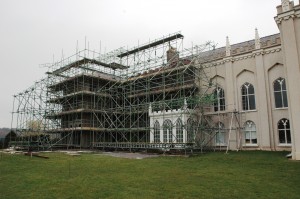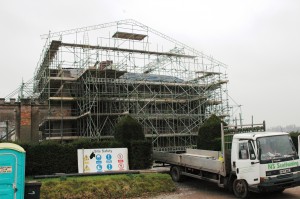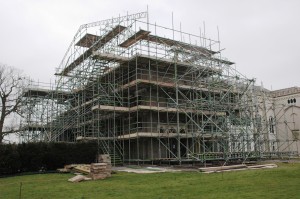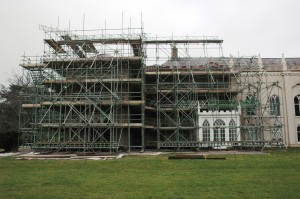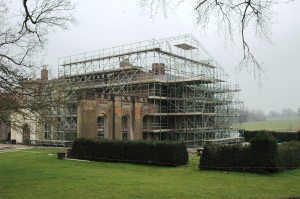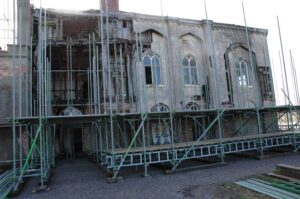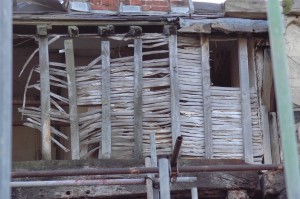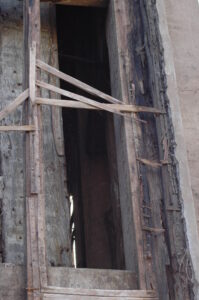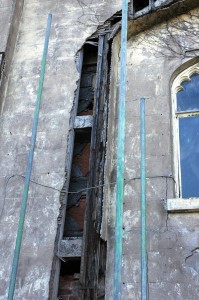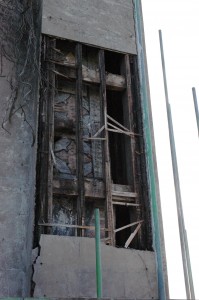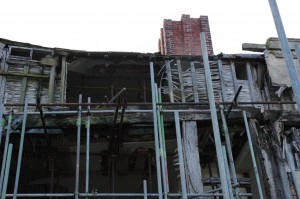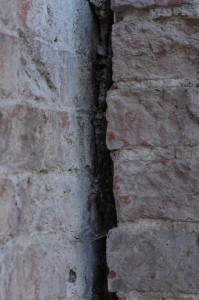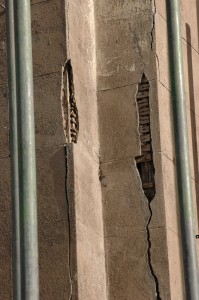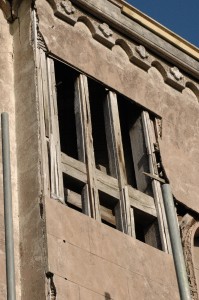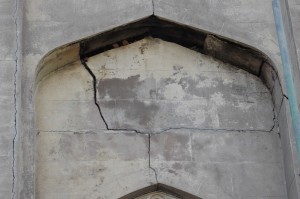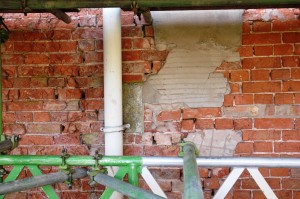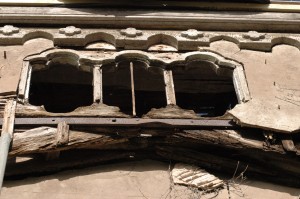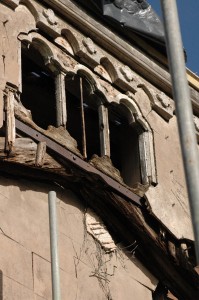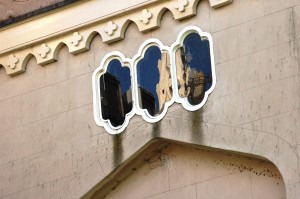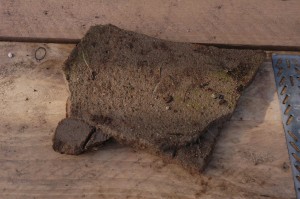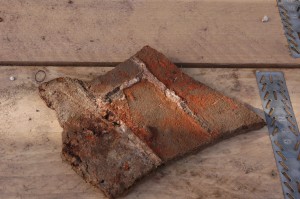The coving on The Library has been cleaned, stripped and left to stabilise, and now the first test coats of paint are being applied. All the colours being used are historically accurate, both in terms of the hues and their composition.
Part of the scaffolding platform is being removed so that the test colours can be seen from ground level, and by the natural light which comes through the west-facing range of windows. The base colour tried first is a light, dusty green, and the mouldings are picked out in a mid-grey (with some green in it).
 Where mouldings have broken off they are carefully repaired on a temporary work bench and are then re-attached by whatever method is appropriate. By and large, substantial and intrusive fixing is avoided. These pieces of plaster can be returned to their rightful place with new plaster.
Where mouldings have broken off they are carefully repaired on a temporary work bench and are then re-attached by whatever method is appropriate. By and large, substantial and intrusive fixing is avoided. These pieces of plaster can be returned to their rightful place with new plaster.
 The majority of the tools used resemble the contents of a sculptor’s tool kit. Few power tools are used; this small mains-operated sanding and buffing tool, with its very fine heads, is as large as they get.
The majority of the tools used resemble the contents of a sculptor’s tool kit. Few power tools are used; this small mains-operated sanding and buffing tool, with its very fine heads, is as large as they get.
 As mentioned previously, some of the heraldic shields have split across a line between the two retaining steel bolts. This was a simple way of fitting them, but has not stood up to holding their weight over the passage of time. It has been possible to repair some of the shields in place, but others have had to be removed – which does make other damage easier to repair. These will be re-secured to the remaining element as simply as possible. Once back in place there will be no evidence of repair from close up, let alone from floor level once the scaffolding platform is removed.
As mentioned previously, some of the heraldic shields have split across a line between the two retaining steel bolts. This was a simple way of fitting them, but has not stood up to holding their weight over the passage of time. It has been possible to repair some of the shields in place, but others have had to be removed – which does make other damage easier to repair. These will be re-secured to the remaining element as simply as possible. Once back in place there will be no evidence of repair from close up, let alone from floor level once the scaffolding platform is removed.
 The south west corner of the early Seventeenth century coving on The Library ceiling. The new colours have been applied (around the two shields which can be fully seen on the left), and on the scroll catouches. The scaffolding will be removed in this corner so that the new paint can be seen and considered from ground level – some twelve or so feet lower.
The south west corner of the early Seventeenth century coving on The Library ceiling. The new colours have been applied (around the two shields which can be fully seen on the left), and on the scroll catouches. The scaffolding will be removed in this corner so that the new paint can be seen and considered from ground level – some twelve or so feet lower.
 With the new paint on the coving and the moulding, attention will turn to the shields. These will be cleaned but new paint will only be applied where absolutely necessary. A small number of shields have been over-painting – not for repair but to change the details of the heraldry, and need more restoration. Stripping back the layers to see what is underneath – and trying to work out why they were re-painted – will be fascinating. The policy is to touch in the paint only where there is a loss of the original paint and the image no longer makes visual sense. As much original paint as possible will be retained.
With the new paint on the coving and the moulding, attention will turn to the shields. These will be cleaned but new paint will only be applied where absolutely necessary. A small number of shields have been over-painting – not for repair but to change the details of the heraldry, and need more restoration. Stripping back the layers to see what is underneath – and trying to work out why they were re-painted – will be fascinating. The policy is to touch in the paint only where there is a loss of the original paint and the image no longer makes visual sense. As much original paint as possible will be retained.
 The moulded wooden cartouche behind each shield will be painted to match the coving behind it, but because they are in relief they are tending to look a shade lighter simply because they catch more light. The right hand side of this cartouche has been re-painted and shows the contrast with the old paint, which has been darkened by smoke and dust over many generations. The central shield is in good condition, and when cleaned will be entirely acceptable.
The moulded wooden cartouche behind each shield will be painted to match the coving behind it, but because they are in relief they are tending to look a shade lighter simply because they catch more light. The right hand side of this cartouche has been re-painted and shows the contrast with the old paint, which has been darkened by smoke and dust over many generations. The central shield is in good condition, and when cleaned will be entirely acceptable.
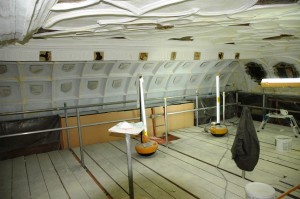 At the north end of The Library the smaller, flat shields are still masked off. They are far less complex than the larger relief shields and should need a lot less attention.
At the north end of The Library the smaller, flat shields are still masked off. They are far less complex than the larger relief shields and should need a lot less attention.
